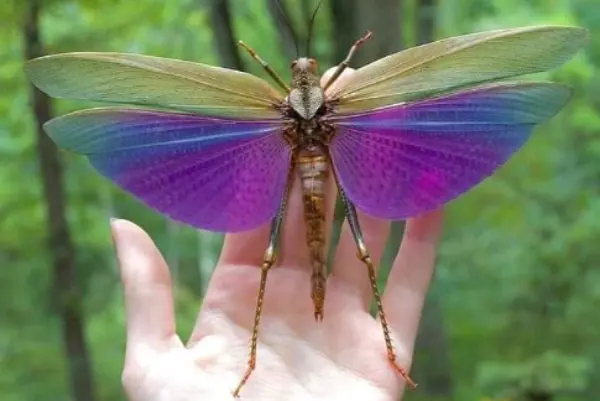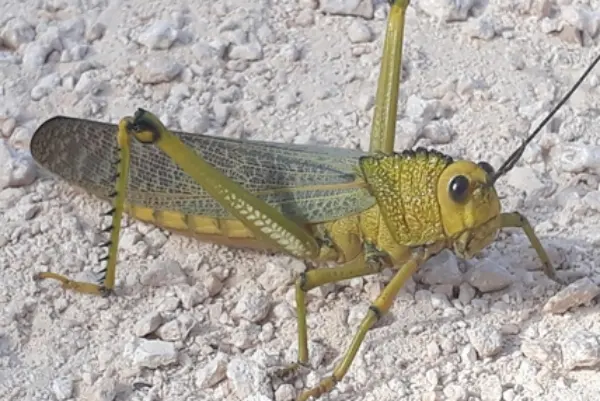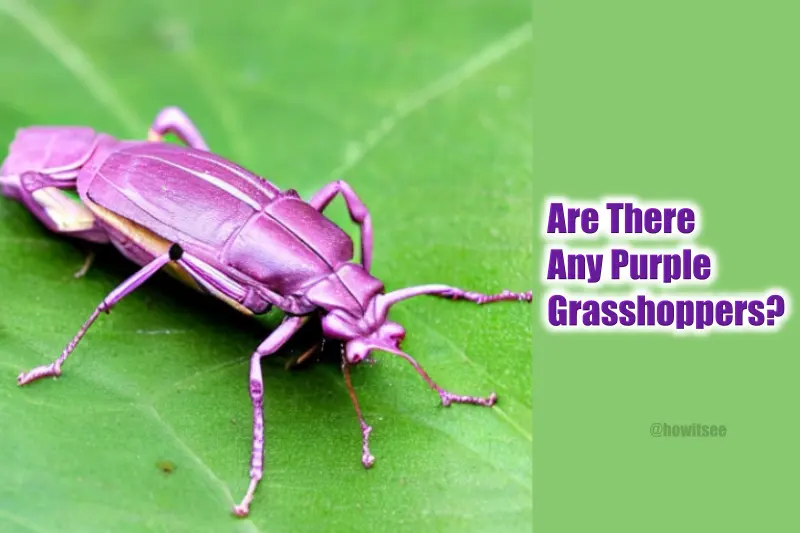Have you ever wondered if there are purple grasshoppers out there? Grasshoppers are known for their incredible hopping skills and vibrant colors, but purple grasshoppers sound like something out of a fairy tale.
In this article, we will deep dive to discover if purple grasshoppers exist, why they’re so rare, and explore the fascinating world of grasshopper coloration. Get ready for a colorful adventure!
Why Are There Very Few Purple Grasshoppers?
Purple grasshoppers are very rare because they can be easily spotted by the predators in the environment. Their shiny purple patterns even attract many predators around them.
Survival and reproduction become a challenge when you’re easily visible to hungry predators, leading to a smaller population of purple grasshoppers.
In addition, the purple coloration in grasshoppers is the result of genetic mutations. These mutations occur randomly and are quite rare compared to the dominant colors we usually see in grasshoppers.
So, the chances of finding a purple grasshopper are pretty slim. It’s like finding a rare gem in a field of pebbles!
What Is Erythrism In Grasshoppers, And How is it Related To The Purple Color?
Erythrism describes a genetic condition where an organism produces excessive red pigments. But in the case of grasshoppers, erythrism can result in the overexpression of red or purple pigments, giving them that eye-catching purple hue.
According to National Geographic, this rare phenomenon is similar to albinism. But here, it can reduce or even omit the normal pigment and/or produce an excessive amount of other pigments, in this case, red which results in pink morphs.
That’s why pinkish hues are also visible in the purple grasshoppers.
Difference Between Nymphs vs. Instars vs. Morphs Grasshoppers
Let’s discuss this in short. Grasshoppers go through three stages in their life: egg -> nymph -> adult.
So, the nymph is the second stage of a grasshopper’s life, or we can say kids grasshopper. They’re small, lack wings, and look like mini versions of the adults. As they grow, they molt, shedding their exoskeleton and developing a new one. Each time they molt, it’s called an instar.
Morph is the overall appearance or coloration of a particular grasshopper species.
7 Purple Grasshoppers
1) Giant Purple-winged Grasshopper

Let’s begin the list of purple grasshoppers with the giant purple-winged grasshopper, scientific name Titanacris Albipes, & family Romaleidae.
These massive grasshoppers are native to central and southern America. They have vibrant yellow and purple color wings with black markings. They have various habitats, from forested areas to grassy landscapes.
2) Reticulate Lubber Grasshopper
Lubber Grasshopper, scientific name Taeniopoda reticulata, is a distinct species of grasshopper that display a remarkable purple coloration adorned with intricate black patterns on its body.
These grasshoppers are found in Central America and are often seen in summer time from early June to July at their nymphal stage to fully matured.
The habitat of Reticulate Lubber Grasshoppers is tropical dry forest where they primarily feed on foliage, flowers, and seed pods of low-growing summer desert annuals. They can grow up to 2 inches long.
3) Giant Red-winged Grasshopper

Giant Red-winged Grasshoppers, scientifically, Tropidacris cristata, are one of the largest insects in the world with a size of 14 cm in length and 24 cm wingspan.
They have a predominately red color with touches of purple on the back side of their wings. They have very beautiful purple and yellow patterns all over the wings.
Those purple accents on its wings act as a warning sign to predators, letting them know it’s not a tasty treat. Giant Red-winged Grasshoppers have various habitats, from grasslands to meadows. These grasshoppers only feed on grasses and sedges.
4) Clear-winged Grasshopper Nymphs
Here, we are taking the nymphs of the Clear-winged Grasshopper, Camnula pellucida. These nymphs have little transparent wings, but their bodies can show off shades of purple, thanks to erythrism.
They have various habitats, including grassy fields, forests, near water bodies, etc. With their see-through wings and purple bodies, these grasshoppers lack camouflage and become easy prey for many predators.
Its unique hue, a result of genetic mutations, adds an enchanting touch to the diverse world of grasshoppers.
5) Costa Rican Purple Grasshopper

Costa Rican Purple Grasshoppers, scientific name, Taeniopoda reticulata, are magnificent purple grasshoppers with black patterns found in the lush rainforests of Costa Rica. They are one of the biggest grasshoppers with orange antennae, shiny purple bodies, purple and black wings, and glossy black legs.
They are mostly found in tropical regions with a good size of 1-1.5 inches. The purple hue of the Costa Rican Purple Grasshopper is believed to play a role in attracting mates and showing off their territory.
6) Stripe-winged Grasshopper Female
Now, you’re wondering why we have listed a green grasshopper in the list. But here, we have mentioned the females of the Stripe-winged Grasshopper, Stenobothrus lineatus. These grasshoppers have green bodies with purple legs.
While the males have rock green or brown colors, females have brownish-pink legs and patterns on the back side and are slightly larger than them. One can easily distinguish between the male and female of the Stripe-winged Grasshopper.
7) Formidable Pygmy Grasshopper
Formidable Pygmy Grasshopper, scientific name Notocerus formidabilis Günther, is an alien-looking grasshopper. If you look closely, these grasshoppers have a black hood on the top with yellow spots.
The females have purple and yellow stripes on the back of the body. They are very small grasshoppers found in distinct habitats like grasslands and woodlands.
Formidable Pygmy Grasshoppers are very colorful grasshoppers with impressive camouflage abilities. If you want to know more about these grasshoppers, I recommend reading this article.
Conclusion
Here, we conclude our article on purple grasshoppers. While purple grasshoppers are indeed a rare sight, they do exist in the insect world, adding a touch of magic to our surroundings.
Their scarcity can be attributed to their vulnerability and the randomness of genetic mutations. We’ve also learned about erythrism, the phenomenon that brings that lovely purple color to these hopping wonders.
From giant purple grasshoppers to colorful nymphs, the world of purple grasshoppers is full of surprises and beauty.
Frequently Asked Questions
Q1. Are purple grasshoppers dangerous?
Ans. No, purple grasshoppers are harmless to humans. They’re herbivores, so they’re more interested in munching on leaves than causing any trouble. However, some grasshoppers are poisonous, like koppie foam grasshoppers.
Q2. Can I keep a purple grasshopper as a pet?
Ans. While it might be tempting to have a purple grasshopper as a pet, it’s not recommended. Grasshoppers require specific care and environments that can be challenging to provide at home.
Q3. How do purple grasshoppers protect themselves from predators?
Purple grasshoppers have a few tricks up their sleeves to stay safe. They use camouflage, their impressive jumping skills, and even warning colors to ward off predators.
Q4. Are purple grasshoppers found in North America?
While purple grasshoppers are more commonly found in tropical and arid regions, there have been occasional sightings of Reticulate Lubber Grasshoppers in North America.
Q5. Can grasshoppers change their color?
Grasshoppers can’t change their color at will. Their coloration is determined by their genes and the pigments present in their exoskeleton.
Also Read:

Meet Abhidept (nickname Monty), the visionary founder of How It See, being an engineering student, he’s fueled by an insatiable curiosity about the world around him. He is captivated by an eclectic correlation between animal groups, science, and nature, and this fascination drives his quest for understanding.
After completing his degree, he’s set on a mission to delve deep into the realm of nature, accumulating knowledge to share with you through his writing. In the meantime, he loves to watch anime and read anime.
